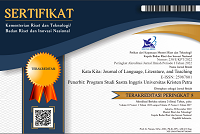THE MOTIVATION OF SOCIAL SCIENCE AND SCIENCE STUDENTS IN LEARNING ENGLISH
DOI:
https://doi.org/10.9744/katakita.2.3.53-58Keywords:
Pelayanan Pelanggan, Atmosfer Toko, Periklanan dan Promosi, Lokasi Toko, Produk, dan HargaAbstract
This is a quantitative study which examined the influence of background of the study (Social Science and Science) in students’ motivation to learn English. Social Science was represented by Faculty of Economy while Science was represented by Faculty of Industrial Technology. Data collection was done by using survey technique in which 100 respondents from each background of study filled in the questionnaires which were handed to them. Theory used in this study is Socio-Educational Model by Gardner (2005). The result of this study showed that there is no significant difference between Social Science and Science students in learning English. It can be concluded that in Indonesia, background of the study does not have a significant influence in determining students’ motivation to learn English.
References
Dӧrnyei, Z. (2005). The psychology of the language learner: Individual differences in second language acquisition. London: Lawrence Erlbaum Associates.
Gardner, R. (2005). Integrative motivation and second language acquisition. Canada: Canadian Association of Applied Linguistics/Canadian Linguistics Association.
Kissau, S. (2006). Gender differences in second language motivation: An investigation of micro-and macro-level influences. Canadian Journal of Applied Linguistics, 9 (1), 73 – 96. Retrieved June 20, 2013 from http://journals.hil.unb.ca/index.php/CJAL/article/viewFile/19755/21453
Pallant, J. (2007). SPSS Survival Manual: A Step by Step Guide to Data Analysis using SPSS for Windows 3rd edition. Sydney: McGraw Hill.
Downloads
Issue
Section
License
Authors who publish with this journal agree to the following terms:- Authors retain copyright and grant the journal right of first publication with the work simultaneously licensed under a Creative Commons Attribution License that allows others to share the work with an acknowledgement of the work's authorship and initial publication in this journal.
- Authors are able to enter into separate, additional contractual arrangements for the non-exclusive distribution of the journal's published version of the work (e.g., post it to an institutional repository or publish it in a book), with an acknowledgement of its initial publication in this journal.
- Authors are permitted and encouraged to post their work online (e.g., in institutional repositories or on their website) prior to and during the submission process, as it can lead to productive exchanges, as well as earlier and greater citation of published work (See The Effect of Open Access).














